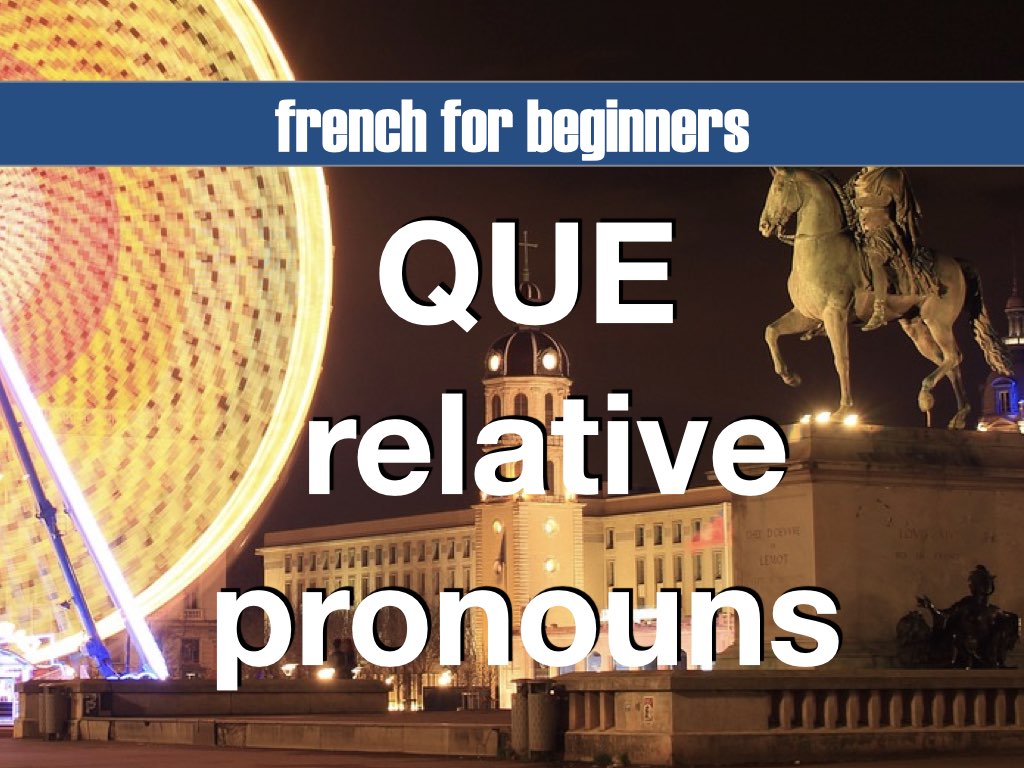Lesson: Understanding the French Relative Pronoun “Que”
Introduction
Welcome to this lesson on the French relative pronoun “que.” This important grammatical tool helps connect parts of sentences to make more complex and detailed statements. It’s used across various contexts and can refer to people, places, things, or ideas. In this lesson, aimed specifically at English-speaking learners, we’ll explore the different ways “que” is used in French sentences.
I. Definition
“Que” is a versatile relative pronoun that serves to link clauses by referring back to an antecedent, which can be animate (people, animals) or inanimate (objects, concepts). The antecedent can be of any gender (masculine, feminine) and number (singular, plural). In speech and before a vowel, “que” often contracts to “qu’” for ease of pronunciation.
II. Functions of French relative pronoun “Que”
A. Direct Object
The most common use of “que” is as a direct object in a relative clause.
Example Sentences:
– Le livre que je lis est intéressant. The book that I am reading is interesting.
– Tu ne manges pas le gâteau que j’ai acheté. You are not eating the cake that I bought.
– Elles regardent le film que j’ai vu hier. They are watching the movie that I saw yesterday.
In these examples, “que” introduces additional information about the antecedent (book, cake, movie) and serves as the object of the action in the clause.
B. Subject Complement
In certain structures, “que” functions to provide additional descriptive detail about the subject.
Example Sentences:
– Nous adorons cette belle région qu’est la Normandie. We adore this beautiful region which is Normandy.
– La chance est que cela ne les intéresse probablement plus. The luck is that it probably no longer interests them.
– La vérité est que vous mentez ! The truth is that you are lying!
C. Indirect Object
“Que” can also relate to an indirect object, usually following a preposition.
Example Sentences:
– C’est à cette personne que nous avons écrit. It’s to this person that we wrote.
– C’est à cette femme que vous avez parlé. It’s to this woman that you spoke.
D. Actual Subject
Sometimes “que” is part of a subject phrase, especially in expressions like “ce que” (what).
Example Sentences:
– Nous vous donnerons ce qu’il vous manque. We will give you what you lack.
– Je vous dirai ce qu’il y a à faire. I will tell you what there is to do.
– Elles feront ce qu’il faut. They will do what is necessary.
🍀 Exercises 🍀
Translation Exercise: Utilizing the French Relative Pronoun “Que”
Translate the following sentences into French, applying the relative pronoun “que” according to the context described in points A (Direct Object), B (Subject Complement), C (Indirect Object), and D (Actual Subject):
🔷 Direct Object (A):
- The book that I found is on the table.
- The movie that we want to watch is not available.
- The songs that she likes are from the 80s.
🔷 Subject Complement (B):
- The problem is that I have no time.
- The good news is that we won the game.
- The truth is that he never knew.
🔷 Indirect Object (C):
- It’s to that teacher that they explained the problem.
- It’s to this client that I sent the report.
- It’s to those children that she read the story.
🔷 Actual Subject (D):
- You will understand what we explained.
- She will say what she thinks.
- I will show you what I found.
Conclusion French relative pronoun “que”
“Que” is a key component of French that allows you to connect ideas within a sentence, making your speech and writing more fluid and nuanced. Understanding and practicing the use of “que” will greatly enhance your ability to communicate complex ideas in French. Remember, practice makes perfect, so use these exercises to help solidify your understanding of this essential french relative pronoun.


